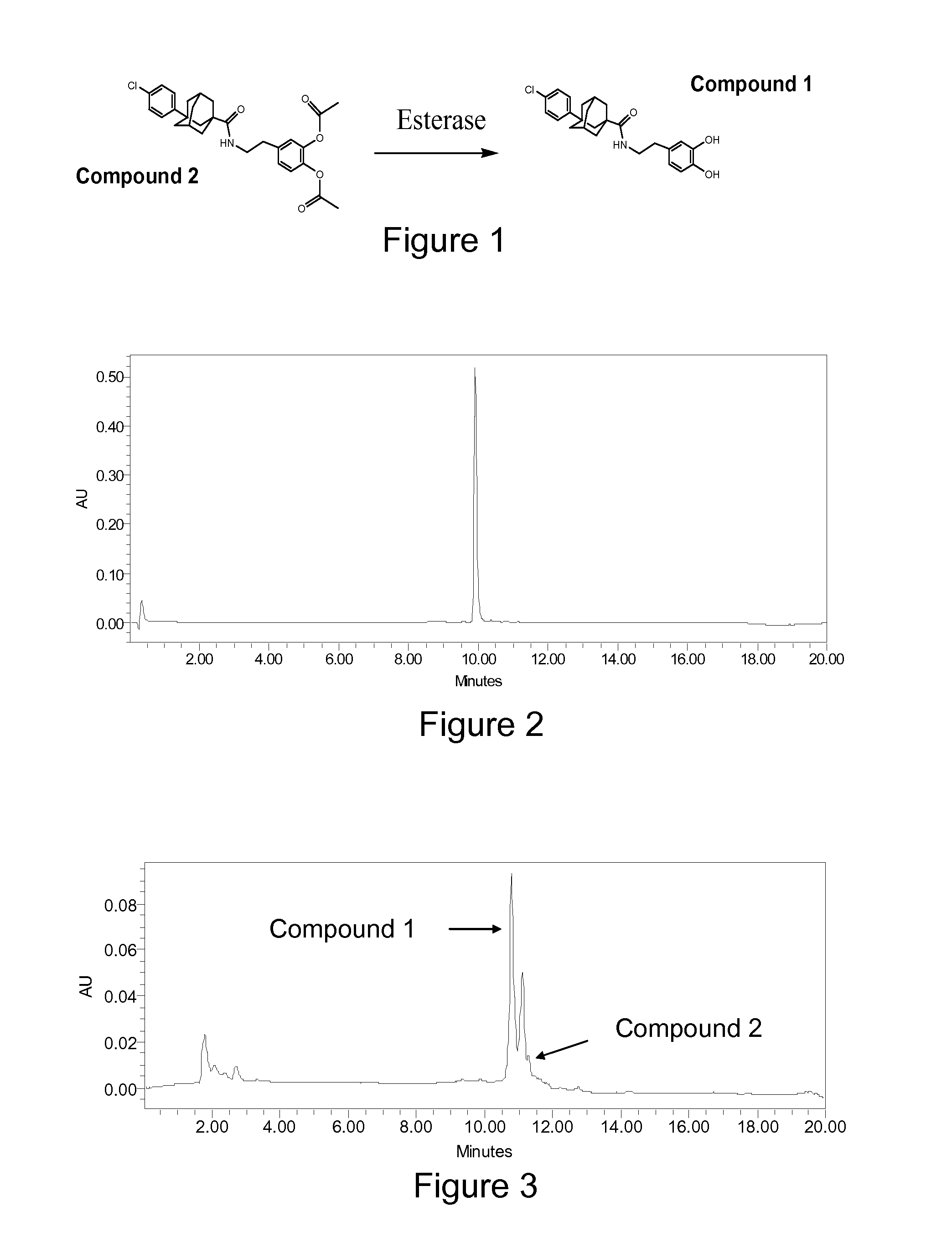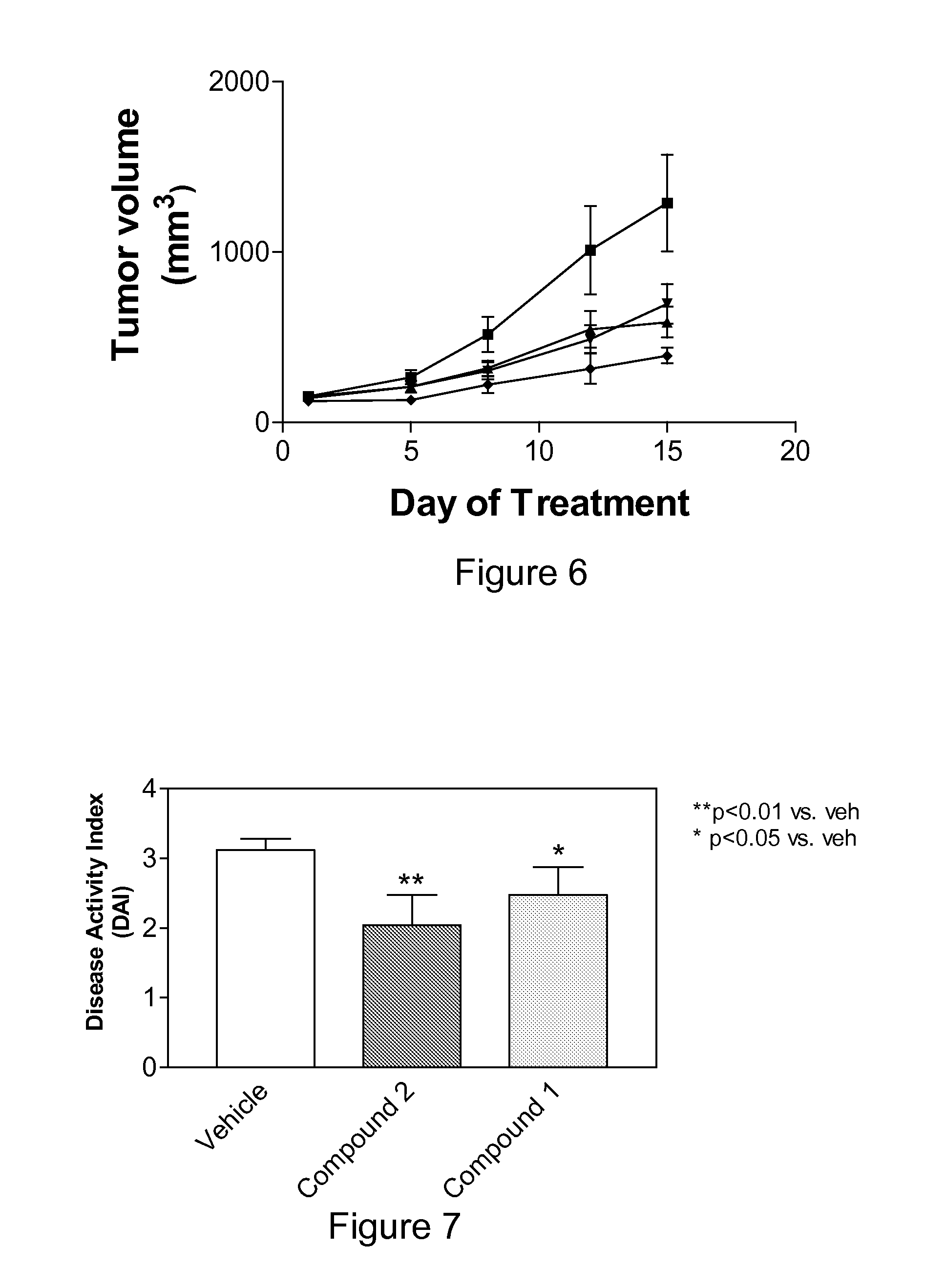Sphingosine Kinase Inhibitor Prodrugs
a kinase inhibitor and prodrug technology, applied in the field of prodrug compounds, can solve the problems of excessive angiogenesis, allowing the progression of disease, and/or producing undesired effects in patients, and achieve the effect of greater potency and greater efficacy
- Summary
- Abstract
- Description
- Claims
- Application Information
AI Technical Summary
Benefits of technology
Problems solved by technology
Method used
Image
Examples
example 1
Method for the Synthesis of 3-(4-chlorophenyl)adamantane-1-carboxylic acid [2-(3,4-dihydroxyphenyl)ethyl]amide: Compound 1.
[0160]The general synthetic approach involved the bromination of adamantane-1-carboxylic acid (1) in the presence of aluminum chloride (AlCl3) to give intermediate (2) which was converted to intermediate (3) by a Friedel-Crafts reaction in the presence of FeCl3. Intermediate 3 was reacted with thionyl chloride (SOCl2) to give intermediate (4). By reaction of intermediate 4 with 3-hydroxytyramine hydrochloride (5) in DMF, Compound 1 was obtained.
[0161]More specifically, adamantane-1-carboxylic acid (1) (45 g, 0.25 mol) was added to a mixture of AlCl3 (45 g, 0.34 mol) and Br2 (450 g) at 0° C. and stirred at 0-10° C. for 48 hrs, and then kept for 5 hrs at about 20° C. The mixture was then poured onto 500 g crushed ice, diluted with 300 mL of CHCl3 and decolorized with solid Na2S2O5. The aqueous phase was extracted twice with Et2O (50 mL each), and the combined orga...
example 2
Method for the Synthesis of acetic acid 2-acetoxy-4-(2-{[3-(4-chlorophenyl)adamantane-1-carbonyl]amino}ethyl)phenyl ester: Compound 2.
[0163]
[0164]Compound 1 (1 g) was dissolved in 10 mL of acetic anhydride with a catalytic amount of 98% H2SO4 and stirred under N2 for 3 days at room temperature. The solution was then concentrated under a vacuum and filtered to give the product Compound 2 (yield=54%), with a melting point of 160-162° C. 1H NMR (500 MHz, CDCl3) δ 1.74 (m, 2H, Admant-H), 1.81-1.88 (m, 8H, Admant-H), 1.93 (s, 2H, Admant-H), 2.26-2.27 (m, 2H, Admant-H), 2.28 (s, 3H, COCH3), 2.31 (s, 3H, COCH3), 2.83-2.85 (t, J=5 Hz, 2H, CH2), 3.50-3.54 (q, 2H, NCH2), 5.69 (s, 1H, NH), 7.01-7.02 (d, J=5 Hz, 1H, Ar—H), 7.07-7.09 (d,d, 1H, H—Ar), 7.13-7.15 (d, J=10 Hz, 1H, Ar—H), 7.30 (s, 4H, Ar—H). 13C NMR (500 MHz, CDCl3) δ 20.6, 20.7, 28.8, 35.0, 35.5, 36.5, 38.3, 40.2, 40.3, 41.7, 42.0, 44.5, 123.5, 124.0, 126.4, 127.0, 128.3, 131.5, 138.0, 140.6, 142.0, 148.4, 168.4, 168.5, 177.5. Mass ...
example 3
Method for the Synthesis of propionic acid 2-propionyloxy-5-(2-{[3-(4-chlorophenyl)adamantane-1-carbonyl]amino}ethyl)phenyl ester: Compound 3.
[0166]
Compound 1 was dissolved in propionic anhydride with a catalytic amount of 98% H2SO4 and stirred under N2 for 3 days at room temperature. The solution was then concentrated under a vacuum and filtered to give the product Compound 3, with a melting point of 114-115° C. 1H NMR (500 MHz, CDCl3) δ 1.24-1.30 (m, 6H, 2CH3), 1.74 (m, 2H, Admant-H), 1.84-1.87 (m, 8H, Admant-H), 1.93 (s, 2H, Admant-H), 2.26 (m, 2H, Admant-H), 2.53-2.61 (m, 4H, 2COCH2), 2.82-2.85 (t, J=7.5 Hz, 2H, CH2), 3.50-3.54 (q, 2H, NCH2), 5.40 (s, 1H, NH), 7.01-7.02 (d, J=5 Hz, 1H, Ar—H), 7.06-7.08 (d,d, 1H, H—Ar), 7.13-7.15 (d, J=10 Hz, 1H, Ar—H), 7.30 (s, 4H, Ar—H); 13C NMR (500 MHz, CDCl3) δ 9.1, 27.5, 28.8, 35.0, 35.5, 36.5, 38.3, 40.3, 41.7, 42.0, 44.5, 123.5, 123.9, 126.4, 126.8, 128.3, 131.5, 137.8, 140.7, 142.1, 148.4, 171.7, 171.8, 177.4; MS m / z (relative intensity)...
PUM
| Property | Measurement | Unit |
|---|---|---|
| Structure | aaaaa | aaaaa |
Abstract
Description
Claims
Application Information
 Login to View More
Login to View More - R&D
- Intellectual Property
- Life Sciences
- Materials
- Tech Scout
- Unparalleled Data Quality
- Higher Quality Content
- 60% Fewer Hallucinations
Browse by: Latest US Patents, China's latest patents, Technical Efficacy Thesaurus, Application Domain, Technology Topic, Popular Technical Reports.
© 2025 PatSnap. All rights reserved.Legal|Privacy policy|Modern Slavery Act Transparency Statement|Sitemap|About US| Contact US: help@patsnap.com



